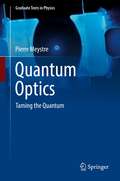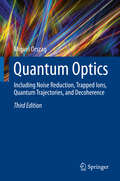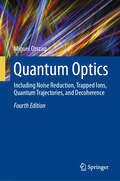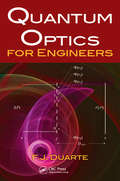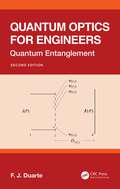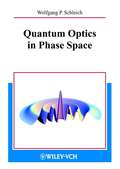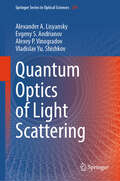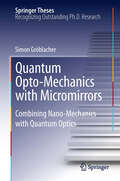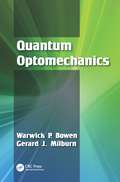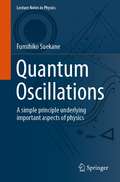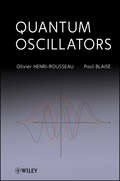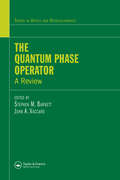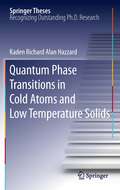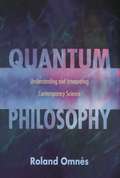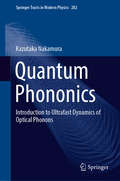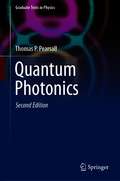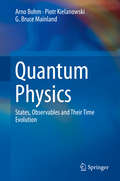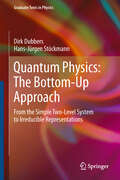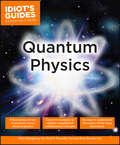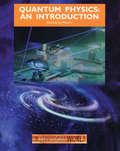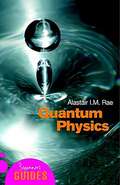- Table View
- List View
Quantum Optics
by Girish S. AgarwalIn the last decade many important advances have taken place in the field of quantum optics, with numerous potential applications. Ideal for graduate courses on quantum optics, this textbook provides an up-to-date account of the basic principles of the subject. Focusing on applications of quantum optics, the textbook covers recent developments such as engineering of quantum states, quantum optics on a chip, nano-mechanical mirrors, quantum entanglement, quantum metrology, spin squeezing, control of decoherence and many other key topics. Readers are guided through the principles of quantum optics and their uses in a wide variety of areas including quantum information science and quantum mechanics. The textbook features end-of-chapter exercises with solutions available for instructors at www. cambridge. org/9781107006409. It is invaluable to both graduate students and researchers in physics and photonics, quantum information science and quantum communications.
Quantum Optics: Taming the Quantum (Graduate Texts in Physics)
by Pierre MeystreThis book is a thoroughly modern and highly pedagogical graduate-level introduction to quantum optics, a subject which has witnessed stunning developments in recent years and has come to occupy a central role in the 'second quantum revolution'. The reader is invited to explore the fundamental role that quantum optics plays in the control and manipulation of quantum systems, leading to ultracold atoms, circuit QED, quantum information science, quantum optomechanics, and quantum metrology. The building blocks of the subject are presented in a sequential fashion, starting from the simplest physical situations before moving to increasingly complicated ones. This pedagogically appealing approach leads to quantum entanglement and measurement theory being introduced early on and before more specialized topics such as cavity QED or laser cooling. The final chapter illustrates the power of scientific cross-fertilization by surveying cutting-edge applications of quantum optics and optomechanics in gravitational wave detection, tests of fundamental physics, searches for dark matter, geophysical monitoring, and ultraprecise clocks. Complete with worked examples and exercises, this book provides the reader with enough background knowledge and understanding to follow the current journal literature and begin producing their own original research.
Quantum Optics
by Miguel OrszagThis new edition gives a unique and broad coverage of basic laser-related phenomena that allow graduate students, scientists and engineers to carry out research in quantum optics and laser physics. It covers quantization of the electromagnetic field, quantum theory of coherence, atom-field interaction models, resonance fluorescence, quantum theory of damping, laser theory using both the master equation and the Langevin theory, the correlated emission laser, input-output theory with applications to non-linear optics, quantum trajectories, quantum non-demolition measurements and generation of non-classical vibrational states of ions in a Paul trap. In this third edition, there is an enlarged chapter on trapped ions, as well as new sections on quantum computing and quantum bits with applications. There is also additional material included for quantum processing and entanglement. These topics are presented in a unified and didactic manner, each chapter is accompanied by specific problems and hints to solutions to deepen the knowledge.
Quantum Optics: Including Noise Reduction, Trapped Ions, Quantum Trajectories, and Decoherence
by Miguel OrszagThis revised new edition gives a unique and broad coverage of basic laser-related phenomena that allow graduate students, scientists and engineers to carry out research in quantum optics and laser physics. It covers quantization of the electromagnetic field, quantum theory of coherence, atom-field interaction models, resonance fluorescence, quantum theory of damping, laser theory using both the master equation and the Langevin theory, the correlated emission laser, input-output theory with applications to non-linear optics, quantum trajectories, quantum non-demolition measurements and generation of non-classical vibrational states of ions in a Paul trap. This fourth edition provides a new chapter on weak measurement, as well as a new chapter on complementarity. There is also new material included for atom optics and new problems have been added. Each topic is presented in a unified and didactic manner, and is accompanied by specific problems and hints to solutions to deepen the knowledge.
Quantum optics
by Marlan O. Scully M. Suhail ZubairyThe field of quantum optics has witnessed significant theoretical and experimental developments in recent years. This book provides an in-depth and wide-ranging introduction to the subject, emphasising throughout the basic principles and their applications. The book begins by developing the basic tools of quantum optics, and goes on to show the application of these tools in a variety of quantum optical systems, including lasing without inversion, squeezed states and atom optics. The final four chapters are devoted to a discussion of quantum optical tests of the foundations of quantum mechanics, and to particular aspects of measurement theory. Assuming only a background of standard quantum mechanics and electromagnetic theory, and containing many problems and references, this book will be invaluable to graduate students of quantum optics, as well as to researchers in this field.
Quantum Optics for Engineers
by F.J. DuarteQuantum Optics for Engineers provides a transparent and methodical introduction to quantum optics via the Dirac's bra–ket notation with an emphasis on practical applications and basic aspects of quantum mechanics such as Heisenberg's uncertainty principle and Schrodinger's equation. Self-contained and using mainly first-year calculus and algebra tools, the book: Illustrates the interferometric quantum origin of fundamental optical principles such as diffraction, refraction, and reflection Provides a transparent introduction, via Dirac's notation, to the probability amplitude of quantum entanglement Explains applications of the probability amplitude of quantum entanglement to optical communications, quantum cryptography, quantum teleportation, and quantum computing. Quantum Optics for Engineers is succinct, transparent, and practical, revealing the intriguing world of quantum entanglement via many practical examples. Ample illustrations are used throughout its presentation and the theory is presented in a methodical, detailed approach.
Quantum Optics for Engineers: Quantum Entanglement
by F.J. DuarteThe second edition of Quantum Optics for Engineers: Quantum Entanglement is an updated and extended version of its first edition. New features include a transparent interferometric derivation of the physics for quantum entanglement devoid of mysteries and paradoxes. It also provides a utilitarian matrix version of quantum entanglement apt for engineering applications.Features: Introduces quantum entanglement via the Dirac–Feynman interferometric principle, free of paradoxes. Provides a practical matrix version of quantum entanglement which is highly utilitarian and useful for engineers. Focuses on the physics relevant to quantum entanglement and is coherently and consistently presented via Dirac’s notation. Illustrates the interferometric quantum origin of fundamental optical principles such as diffraction, refraction, and reflection. Emphasizes mathematical transparency and extends on a pragmatic interpretation of quantum mechanics. This book is written for advanced physics and engineering students, practicing engineers, and scientists seeking a workable-practical introduction to quantum optics and quantum entanglement.
Quantum Optics in Phase Space
by Wolfgang P. SchleichQuantum Optics in Phase Space provides a concise introduction to the rapidly moving field of quantum optics from the point of view of phase space. Modern in style and didactically skillful, Quantum Optics in Phase Space prepares students for their own research by presenting detailed derivations, many illustrations and a large set of workable problems at the end of each chapter. Often, the theoretical treatments are accompanied by the corresponding experiments. An exhaustive list of references provides a guide to the literature. Quantum Optics in Phase Space also serves advanced researchers as a comprehensive reference book. Starting with an extensive review of the experiments that define quantum optics and a brief summary of the foundations of quantum mechanics the author Wolfgang P. Schleich illustrates the properties of quantum states with the help of the Wigner phase space distribution function. His description of waves ala WKB connects semi-classical phase space with the Berry phase. These semi-classical techniques provide deeper insight into the timely topics of wave packet dynamics, fractional revivals and the Talbot effect. Whereas the first half of the book deals with mechanical oscillators such as ions in a trap or atoms in a standing wave the second half addresses problems where the quantization of the radiation field is of importance. Such topics extensively discussed include optical interferometry, the atom-field interaction, quantum state preparation and measurement, entanglement, decoherence, the one-atom maser and atom optics in quantized light fields. Quantum Optics in Phase Space presents the subject of quantum optics as transparently as possible. Giving wide-ranging references, it enables students to study and solve problems with modern scientific literature. The result is a remarkably concise yet comprehensive and accessible text- and reference book - an inspiring source of information and insight for students, teachers and researchers alike.
Quantum Optics of Light Scattering (Springer Series in Optical Sciences #249)
by Alexey P. Vinogradov Alexander A. Lisyansky Evgeny S. Andrianov Vladislav Yu. ShishkovThis book presents a quantum framework for understanding inelastic light scattering which is consistent with the classical descriptions of Raman phenomena and Rayleigh scattering, thus creating a unified theoretical picture of light scattering. The Raman effect was discovered in 1928 and has since proved to be one of the most powerful tools to study the molecular structure of gases, liquids, and crystals. The subsequent development of new scientific disciplines such as nonlinear optics, quantum optics, plasmonics, metamaterials, and the theory of open quantum systems has changed our views on the nature of Rayleigh and Raman scattering. Today, there are many excellent books on the theory and applications of light scattering, but a consistent description of light scattering from a unified viewpoint is missing. The authors’ approach has the power to re-derive the results of both classical and quantum approaches while also addressing many questions that are scattered acrossthe research literature: Why is Rayleigh scattering coherent while Raman scattering is not, although both phenomena are caused by the incidence of a coherent wave? Why are coherent Stokes and coherent anti-Stokes Raman scattering caused by two coherent incident waves both always coherent? This book answers these questions and more, and explains state-of-the-art experimental results with a first-principles approach that avoids phenomenological arguments. Many of the results presented are appearing in book form for the first time, making this book especially useful for young researchers entering the field. The book reviews basic concepts of quantum mechanics and quantum optics and comes equipped with problems and solutions to develop understanding of the key mathematical techniques. The rigorous approach presented in the book is elegant and readily grasped, and will therefore prove useful to both theorists and experimentalists at the graduate level and above, as well as engineers who useRaman scattering methods in their work.
Quantum Opto-Mechanics with Micromirrors
by Simon GröblacherQuantum effects in macroscopic systems have long been a fascination for researchers. Over the past decade mechanical oscillators have emerged as a leading system of choice for many such experiments. The work reported in this thesis investigates the effects of the radiation-pressure force of light on macroscopic mechanical structures. The basic system studied is a mechanical oscillator that is highly reflective and part of an optical resonator. It interacts with the optical cavity mode via the radiation-pressure force. Both the dynamics of the mechanical oscillation and the properties of the light field are modified through this interaction. The experiments use quantum optical tools (such as homodyning and down-conversion) with the goal of ultimately showing quantum behavior of the mechanical center of mass motion. Of particular value are the detailed descriptions of several novel experiments that pave the way towards this goal and are already shaping the field of quantum optomechanics, in particular optomechanical laser cooling and strong optomechanical coupling.
Quantum Optomechanics
by Warwick P. Bowen Gerard J. MilburnWritten by leading experimentalist Warwick P. Bowen and prominent theoretician Gerard J. Milburn, Quantum Optomechanics discusses modern developments in this novel field from experimental and theoretical standpoints. The authors share their insight on a range of important topics, including optomechanical cooling and entanglement; quantum limits on
Quantum Oscillations: A simple principle underlying important aspects of physics (Lecture Notes in Physics #985)
by Fumihiko SuekaneThis book addresses various aspects of physics, using Quantum oscillation (QO) as a common denominator. QO plays an important role in many aspects of physics, such as the Weinberg angle, Caribbo angle, neutrino oscillation, K0 oscillation and CP violation, mass generation by the Higgs field, hadron mass pattern, lepton anomalous magnetic moment, spin precession, hydrogen HI line, etc.Usually, these subjects are taught separately. As such, this book allows readers to learn about a wide range of physics subjects in a unified manner and to gain farther-reaching perspectives. The readers may be surprised at the fact that different looking physics are actually closely related with each other. They will also find essential information on quantum mechanics at the heart from many concrete examples. Though the book is mainly intended for graduate students of particle, nuclear and astrophysics, undergraduate students and researchers will also benefit from the content.
Quantum Oscillations and Charge-Neutral Fermions in Topological Kondo Insulator YbB₁₂ (Springer Theses)
by Yuki SatoElectronic state of every solid is basically classified into two categories according to its electrical responses: insulator or metal. A textbook of modern solid state physics explains that shape of a Fermi surface plays a key role in most physical properties in metals. One of the well-established experimental methods to detect a Fermi surface is measurement of quantum oscillations that is a periodic response of physical quantities with respect to external magnetic fields. As insulators do not host Fermi surface, it is believed that they do not exhibit any quantum oscillations.This book presents a comprehensive review of recent observations of quantum oscillations in the Kondo insulators, SmB6 and YbB12, and discusses how the observations are demonstrated by a newly proposed mechanism where emergent charge-neutral fermions exhibit quantum oscillations instead of bare electrons. It also focuses on topological properties of Kondo insulators, and demonstrates that YbB12 hosts a surface metallic conduction owing to its non-trivial band structure. Further it presents the experiments of specific heat and thermal conductivity in YbB12 down to ultra-low temperature to discuss the possible low-energy excitations from a Fermi surface of neutral fermions. The demonstrated gapless and itinerant fermionic excitations, that is the significant contribution from charge neutral fermions, violates Wiedemann-Franz law. The discoveries point out a highly unconventional phase of quantum state—electrically insulating but thermally metallic—realized in the bulk of topological Kondo insulators.
Quantum Oscillators
by Olivier Henri-Rousseau Paul BlaiseAn invaluable reference for an overall but simple approach to the complexity of quantum mechanics viewed through quantum oscillators Quantum oscillators play a fundamental role in many areas of physics; for instance, in chemical physics with molecular normal modes, in solid state physics with phonons, and in quantum theory of light with photons. Quantum Oscillators is a timely and visionary book which presents these intricate topics, broadly covering the properties of quantum oscillators which are usually dispersed in the literature at varying levels of detail and often combined with other physical topics. These properties are: time-independent behavior, reversible dynamics, thermal statistical equilibrium and irreversible evolution toward equilibrium, together with anharmonicity and anharmonic couplings. As an application of these intricate topics, special attention is devoted to infrared lineshapes of single and complex (undergoing Fermi resonance or Davydov coupling) damped H-bonded systems, providing key insights into this rapidly evolving area of chemical science. Quantum Oscillators is a long overdue update in the literature surrounding quantum oscillators, and serves as an excellent supplementary text in courses on IR spectroscopy and hydrogen bonding. It is a must-have addition to the library of any graduate or undergraduate student in chemical physics.
The Quantum Phase Operator: A Review
by Stephen M. Barnett John A. VaccaroDescribing the phase of an electromagnetic field mode or harmonic oscillator has been an obstacle since the early days of modern quantum theory. The quantum phase operator was even more problematic with the invention of the maser and laser in the 1950s and 1960s. This problem was not solved until the Pegg-Barnett formalism was developed in the 1980
Quantum Phase Transitions
by Subir SachdevDescribing the physical properties of quantum materials near critical points with long-range many-body quantum entanglement, this book introduces readers to the basic theory of quantum phases, their phase transitions and their observable properties. This second edition begins with a new section suitable for an introductory course on quantum phase transitions, assuming no prior knowledge of quantum field theory. It also contains several new chapters to cover important recent advances, such as the Fermi gas near unitarity, Dirac fermions, Fermi liquids and their phase transitions, quantum magnetism, and solvable models obtained from string theory. After introducing the basic theory, it moves on to a detailed description of the canonical quantum-critical phase diagram at non-zero temperatures. Finally, a variety of more complex models are explored. This book is ideal for graduate students and researchers in condensed matter physics and particle and string theory.
Quantum Phase Transitions in Cold Atoms and Low Temperature Solids
by Kaden Richard HazzardThe primary focus of this thesis is to theoretically describe nanokelvin experiments in cold atomic gases, which offer the potential to revolutionize our understanding of strongly correlated many-body systems. The thesis attacks major challenges of the field: it proposes and analyzes experimental protocols to create new and interesting states of matter and introduces theoretical techniques to describe probes of these states. The phenomena considered include the fractional quantum Hall effect, spectroscopy of strongly correlated states, and quantum criticality, among others. The thesis also clarifies experiments on disordered quantum solids, which display a variety of exotic phenomena and are candidates to exhibit so-called "supersolidity." It collects experimental results and constrains their interpretation through theoretical considerations. This Doctoral Thesis has been accepted by Cornell University, Ithaca, USA.
Quantum Philosophy: Understanding and Interpreting Contemporary Science
by Roland OmnèsIn this magisterial work, Roland Omnès takes us from the academies of ancient Greece to the laboratories of modern science as he seeks to do no less than rebuild the foundations of the philosophy of knowledge. One of the world's leading quantum physicists, Omnès reviews the history and recent development of mathematics, logic, and the physical sciences to show that current work in quantum theory offers new answers to questions that have puzzled philosophers for centuries: Is the world ultimately intelligible? Are all events caused? Do objects have definitive locations? Omnès addresses these profound questions with vigorous arguments and clear, colorful writing, aiming not just to advance scholarship but to enlighten readers with no background in science or philosophy. The book opens with an insightful and sweeping account of the main developments in science and the philosophy of knowledge from the pre-Socratic era to the nineteenth century. Omnès then traces the emergence in modern thought of a fracture between our intuitive, commonsense views of the world and the abstract and--for most people--incomprehensible world portrayed by advanced physics, math, and logic. He argues that the fracture appeared because the insights of Einstein and Bohr, the logical advances of Frege, Russell, and Gödel, and the necessary mathematics of infinity of Cantor and Hilbert cannot be fully expressed by words or images only. Quantum mechanics played an important role in this development, as it seemed to undermine intuitive notions of intelligibility, locality, and causality. However, Omnès argues that common sense and quantum mechanics are not as incompatible as many have thought. In fact, he makes the provocative argument that the "consistent-histories" approach to quantum mechanics, developed over the past fifteen years, places common sense (slightly reappraised and circumscribed) on a firm scientific and philosophical footing for the first time. In doing so, it provides what philosophers have sought through the ages: a sure foundation for human knowledge. Quantum Philosophy is a profound work of contemporary science and philosophy and an eloquent history of the long struggle to understand the nature of the world and of knowledge itself.
Quantum Phononics: Introduction to Ultrafast Dynamics of Optical Phonons (Springer Tracts in Modern Physics #282)
by Kazutaka NakamuraThis book presents quantum phononics as an exciting new field of research, and introduces readers to the quantum nature of phonons and their application to quantum technologies. Both the theory of and recent experiments in “quantum phononics,” involving e.g. coherent phonons, phonon squeezing, coherent control, and phonon quantum technologies, are presented. The theoretical background of the generation and detection of phonons is described in a way that will be easy to understand for graduate students and experimental scientists who are newcomers to the field. Moreover, the book focuses on coherent phonons produced by ultrafast laser pulses, which can be used for the coherent control of atomic motions in solids and phase transformation. The laser-matter interaction is treated using a density matrix formalism of the time-dependent Schröedinger equation. In addition, the third-order nonlinear optical response of condensed matter is also described.
Quantum Photonics (Graduate Texts in Physics)
by Thomas P. PearsallPhotonics is the discipline of electrons and photons working in tandem to create new physics, new devices and new applications. This textbook employs a pedagogical approach that facilitates access to the fundamentals of quantum photonics. Beginning with a review of the quantum properties of photons and electrons, the book then introduces the concept of their non-locality at the quantum level. It presents a determination of electronic band structure using the pseudopotential method, enabling the student to directly compute the band structures of most group IV, group III-V, and group II-VI semiconductors. The book devotes further in-depth discussion of second quantization of the electromagnetic field that describes spontaneous and stimulated emission of photons, quantum entanglement and introduces the topic of quantum cascade lasers, showing how electrons and photons interact in a quantum environment to create a practical photonic device.This extended second edition includes a detailed description of the link between quantum photon states and the macroscopic electric field. It describes the particle qualities of quantum electrons via their unique operator algebra and distinguishable behavior from photons, and employs these fundamentals to describe the quantum point contact, which is the quantum analogue of a transistor and the basic building block of all nanoscopic circuits, such as electron interferometers.Pearsall’s Quantum Photonics is supported by numerous numerical calculations that can be repeated by the reader, and every chapter features a reference list of state-of-the art research and a set of exercises. This textbook is an essential part of any graduate-level course dealing with the theory of nanophotonic devices or computational physics of solid-state quantum devices based on nanoscopic structures.
Quantum Physics: States, Observables and Their Time Evolution (Texts And Monographs In Physics #348)
by Arno Bohm Piotr Kielanowski G. Bruce MainlandThis is an introductory graduate course on quantum mechanics, which is presented in its general form by stressing the operator approach. Representations of the algebra of the harmonic oscillator and of the algebra of angular momentum are determined in chapters 1 and 2 respectively. The algebra of angular momentum is enlarged by adding the position operator so that the algebra can be used to describe rigid and non-rigid rotating molecules. The combination of quantum physical systems using direct-product spaces is discussed in chapter 3. The theory is used to describe a vibrating rotator, and the theoretical predictions are then compared with data for a vibrating and rotating diatomic molecule. The formalism of first- and second-order non-degenerate perturbation theory and first-order degenerate perturbation theory are derived in chapter 4. Time development is described in chapter 5 using either the Schroedinger equation of motion or the Heisenberg’s one. An elementary mathematical tutorial forms a useful appendix for the readers who don’t have prior knowledge of the general mathematical structure of quantum mechanics.
Quantum Physics: The Bottom-Up Approach
by Dirk Dubbers Hans-Jürgen StöckmannThis concise tutorial provides the bachelor student and the practitioner with a short text on quantum physics that allows them to understand a wealth of quantum phenomena based on a compact, well readable, yet still concise and accurate description of nonrelativistic quantum theory. This "quadrature of the circle" is achieved by concentrating first on the simplest quantum system that still displays all basic features of quantum theory, namely, a system with only two quantized energy levels. For most readers it is very helpful to understand such simple systems before slowly proceeding to more demanding topics like particle entanglement, quantum chaos, or the use of irreducible tensors. This tutorial does not intend to replace the standard textbooks on quantum mechanics, but will help the average student to understand them, often for the first time.
Quantum Physics (Idiot's Guides)
by Marc Humphrey Paul V. PancellaQuantum physics explores the behavior of matter and energy at the molecular, atomic, nuclear, and even smaller levels. Idiot's Guides: Quantum Physics explores this very complex topic, while making it easy-to-understand for science enthusiasts and students alike. It skips the complicated math and dives right in to all of the concepts, paradoxes, and implications that make quantum physics so fascinating. Topics include quantum vs. classical physics, the famous double-slit experiment, quantum wave function, the Heisenberg Uncertainty Principle, the Schrodinger's cat thought experiment, quantum entanglement, competing interpretations, quantum gravity, and much more.
Quantum Physics: An Introduction
by J MannersQuantum Physics: An Introduction guides you through the profound revolution in scientific thinking that overthrew classical physics in favor of quantum physics. The book discusses the basic ideas of quantum physics and explains its power in predicting the behavior of matter on the atomic scale, including the emission of light by atoms (spectra) and the operation of lasers. It also elucidates why the interpretation of quantum physics is still the subject of intense debate among scientists.
Quantum Physics: A Beginner's Guide (Beginner's Guides)
by Alastair RaeFrom quarks to computing, this fascinating introduction covers every element of the quantum world in clear and accessible language. Drawing on a wealth of expertise to explain just what a fascinating field quantum physics is, Rae points out that it is not simply a maze of technical jargon and philosophical ideas, but a reality which affects our daily lives.

